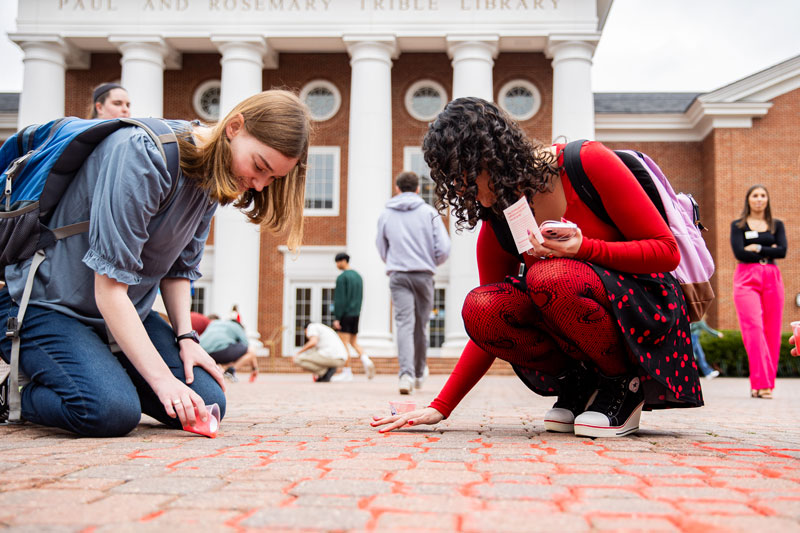
Read time:
Armed with red sand and a commitment to prevention, students, community leaders, and professors demonstrated their concern about the ever-increasing worldwide epidemic of human trafficking.
Called Operation Breakthrough, the event brought attention to the plight of those who fall victim to traffickers, both locally and around the globe. Local non-profit organizations that work to fight human trafficking helped spread the word about what students can do to help.
“The red sand is really cool,” said Adam Clyve, ‘25 Computer Science. He hoped the sight of red sand on campus would ignite conversations and raise awareness of human trafficking.
“Students will walk past it and talk about it all day,” said Clyve, a Bonner Service Scholar who volunteers with Free Kind, a local non profit dedicated to combating human trafficking. “This is important, something everyone needs to know about.”
Pouring red sand between the bricks on the plaza in front of the David Student Union was a visual illustration of how vulnerable people can easily fall between society’s cracks, making them susceptible to human traffickers. Victims are forced into child labor and sex trafficking markets.
“Today is so important,” said Vanessa Buehlman, director of the Center for Community Engagement.
“It gives us a united voice that says we as a community will not tolerate exploitation.”
Provost Quentin Kidd said the event was a platform to take action. “Let’s leave here today with a renewed sense of purpose: to release the shackles of human trafficking,” he said.
The event was sponsored by the City of Newport News. Tiffany Boyle, Newport News Commissioner of Revenue, learned about the Red Sand project at a conference years ago. With human trafficking on the rise worldwide, she believes it’s critical to bring an increased awareness of the problem.
“This helps to open up the conversation,” Boyle said.
The sand, she said, provides a visual reminder of the ways human trafficking can silently infiltrate a community.
“Remember that each grain of sand represents your neighbors, my neighbors, our neighbors who have fallen through the cracks,” she said. Human trafficking is one of the fastest growing industries in the world, with 27.6 million people impacted, according to Virginia Woodward, chief executive officer of Fear 2 Freedom, a non profit dedicated to helping survivors of sexual assault. The industry generates $150 billion in illegal profits each year, she said.
She urged students to be engaged in the effort to stop it.
“Learn the signs,” Woodward said. “Learn what you can do.” For CNU students, the event resonated and served as a call to action. Caroline Jungers, ‘24 Social Work, is also a Bonner Service Scholar who has worked with Free Kind.
“The thing that is important is that anyone is susceptible to human trafficking,” she said. “It’s not just overseas. It’s right here. It has a much broader scope than people realize.”